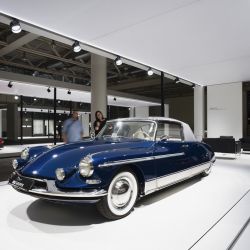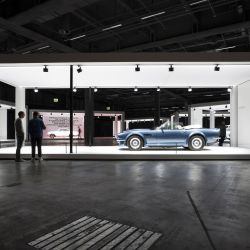
Download this article:
Curved edges of light trace the aerodynamic body shape on azure-blue paint and the polish of chrome parts brilliantly sparkles. Can cars be art? A question that answers itself in the presence of automotive rarities such as the 1958 Citroen DS "Le Croisette". The cabriolet could be seen together with a brace of other beauties at the Grand Basel, a new show for exclusive, classic cars.
If aesthetics alone are not enough, the fact that the "Déesse", with its central hydraulics for suspension, steering and brakes wrote technological history, may prove the relevance of the exhibit. As symbols of progress and objects of desire, classic automobiles always represent the zeitgeist of their creation - and, thanks to limited availability, have long enjoyed the status of both collector's items and financial investments. Accordingly, it seems only plausible that the Swiss exhibition company MCH Group, organisers of the world's leading art fair Art Basel, are focusing on this issue with their new event. After all, who else could draw on a comparable depth of experience with highly aesthetic and costly exhibits, but also with a correspondingly exclusive audience?
"The Grand Basel presents its vehicles as if in a gallery. Nothing should distract from the exhibits."
(Mark Backé, Director of Grand Basel)
Uniform light as an aesthetic framework
The concept of the Grand Basel, which celebrated its premiere from 6 to 9 September 2018, is also based on strict selection. More than one hundred automobiles will be shown - but never more than two or three selected vehicles from a dealer or collector will be positioned in one of the "frames" that make up the exhibition architecture: immaculately white, frame-like platforms that are sealed above by opaque stretch film. This homogeneous form of presentation also includes staging of the exhibits with light. In order to convey an optimal visual impression of shapes, colours and materials, both "live" and in the media via photo or film, the technical parameters for quality of light were defined at an early stage in the design process. Responsible for this was the engineer and lighting designer Andreas Seiler who planned the lighting and other technical elements on behalf of the Berlin design company Blue Scope.
One challenge was the desire to travel with the entire exhibition architecture. Like Art Basel with its international offshoots, Grand Basel will also make stops in Miami, Hong Kong and other locations in the future. For the technology this means: it must not only be portable and efficient to assemble and disassemble, but must also comply with the various power grids, regulations and safety requirements of the host country. To avoid mixed lighting situations in naturally illuminated exhibition halls, the lighting designers specified a daylight-similar light with a 5700K colour temperature - but also very good colour rendering of Ra≥90. Further specifications included dimmability on the housing and flexibility with regard to the beam angle.
"We couldn't find a serial product in the market that met all our criteria."
(Andreas Seiler, lighting designer at 360x media)
"ERCO individual" succeeds all along the line
Potential suppliers, including ERCO, were contacted for this custom lighting solution. At ERCO the possibilities of individualising series products and developing sophisticated special luminaires are brought together as part of the company's "ERCO individual" service. The option proved to be a winning formula: the responsible ERCO lighting consultant rapidly presented a prototype based on the Parscan spotlight series that already largely met the requirements. Later, during extensive sampling at the client's premises in Basel, the individualised Parscan spotlights were finally able to assert themselves in a direct comparison: not only through precise adherence to all technical specifications but also thanks to the product design and the winning visual impression. After a few days at the fair Mark Backé still remains enthusiastic: "It's amazing how well the concept functions," says the director of the Grand Basel. "Working with the spotlights in the frames as the exclusive light sources throughout the hall."
Project data
Client: MCH Group, Basel / Switzerland
Architecture: Blue Scope, Berlin / Germany
Lighting designer: Andreas Seiler, 360x media, Weimar / Germany
Project management: Reto Ginsig, Expomobilia AG, Illnau / Switzerland
Photography: Moritz Hillebrand, Zurich / Switzerland
Products: Parscan, ERCO individual
Photo credits: © ERCO GmbH, www.erco.com, Moritz Hillebrand
Über ERCO
Die ERCO Lichtfabrik mit Sitz in Lüdenscheid ist ein führender Spezialist für Architekturbeleuchtung mit LED-Technologie. Das 1934 gegründete Familienunternehmen operiert weltweit in knapp 40 Ländern mit über 60 Tochtergesellschaften, Niederlassungen und Vertretungen. Seit 2015 basiert das Produktprogramm vollständig auf LED-Technologie. Unter dem Leitmotiv "light digital" entwickelt, gestaltet und produziert ERCO in Lüdenscheid digitale Leuchten mit den Schwerpunkten lichttechnische Optiken, Elektronik und Design. Die Lichtwerkzeuge entstehen in engem Kontakt mit Architekten, Lichtplanern und Elektroplanern und kommen primär in den folgenden Anwendungsbereichen zum Einsatz: Work und Shop, Culture und Community, Hospitality, Living, Public und Contemplation. ERCO versteht digitales Licht als die vierte Dimension der Architektur - und unterstützt Planer dabei, ihre Projekte mit hochpräzisen, effizienten Lichtlösungen in die Realität zu überführen. Sollten Sie weiterführende Informationen zu ERCO oder Bildmaterial wünschen, besuchen Sie uns bitte auf www.erco.com/presse. Gerne liefern wir Ihnen auch Material zu Projekten weltweit für Ihre Berichterstattung.
Relevant image material
© ERCO GmbH, www.erco.com
© ERCO GmbH, www.erco.com
© ERCO GmbH, www.erco.com
© ERCO GmbH, www.erco.com
© ERCO GmbH, www.erco.com
© ERCO GmbH, www.erco.com
© ERCO GmbH, www.erco.com
© ERCO GmbH, www.erco.com
© ERCO GmbH, www.erco.com
© ERCO GmbH, www.erco.com









